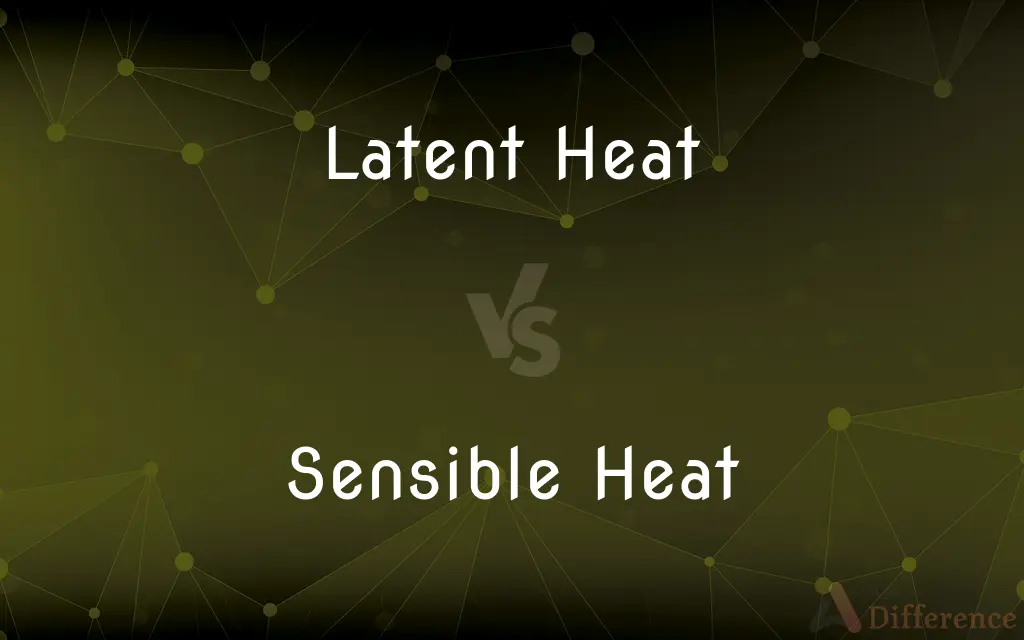Latent Heat vs. Sensible Heat — What's the Difference?
By Tayyaba Rehman — Published on November 5, 2023
Latent heat is the energy absorbed or released during a phase change without a temperature change, while sensible heat causes a change in temperature without changing the phase.

Difference Between Latent Heat and Sensible Heat
Table of Contents
ADVERTISEMENT
Key Differences
Latent Heat and Sensible Heat, while both connected to thermal energy transition, reflect different aspects of heat transfer within a system. Latent Heat essentially involves energy transfer that occurs without a concurrent change in the temperature of a system, particularly exemplified during phase changes like melting or boiling. In contrast, Sensible Heat directly influences the temperature of a system, increasing or decreasing it without navigating through different phases of matter, serving as the type of heat readily perceptible through touch or measurement.
While latent heat doesn’t alter the temperature during a phase transition, it plays a pivotal role in processes like the water cycle, where energy is absorbed by ice to melt into water, without raising the temperature of the resultant water. On the other hand, sensible heat prominently alters the temperature, as witnessed when water is heated on a stove, with its temperature rising steadily, elucidating the tangible aspect of sensible heat in everyday phenomena.
Latent Heat is consequential in meteorology, where it facilitates the formation of clouds through the condensation of water vapor, without a perceptible change in temperature, thus affecting weather patterns. Conversely, sensible heat becomes particularly relevant in activities like cooking, where a discernible change in temperature is instrumental to the preparation of various dishes, highlighting the distinct applications of latent and sensible heat in diverse contexts.
In technological applications, latent heat is crucial for systems like refrigeration, where the absorption of latent heat allows substances to change phase, thereby cooling the surroundings without altering the temperature of the refrigerant. Sensible heat finds its application in systems like heaters, where the aim is to noticeably elevate the temperature of a medium (like water or air), once again displaying the contrasting functionalities of latent and sensible heat in varied technological domains.
Latent Heat's significance in maintaining Earth's climate, particularly through oceanic heat transfer, ensures the stable sustenance of various ecosystems without direct temperature variations. Sensible heat plays a vital role in homeostasis in living organisms, where maintaining a stable internal temperature, through processes like sweating or shivering, is essential for survival, illustrating the holistic and multifaceted impacts of latent and sensible heat on our planet and its inhabitants.
ADVERTISEMENT
Comparison Chart
Definition
Heat absorbed/released without temperature change
Heat that changes temperature without phase change
Example
Melting ice without temperature rise
Heating water and raising its temperature
Application
Refrigeration technology
Cooking and heating applications
Impact on Phase Change
Directly involved in phase changes
Does not cause phase changes
Meteorological Relevance
Influential in cloud formation and weather patterns
Can influence air temperatures and consequent weather
Compare with Definitions
Latent Heat
Climatic Impact
Oceans absorb latent heat, affecting global climate patterns.
Sensible Heat
Non-phase Changing
Sensible heat alters temperatures without changing the phase.
Latent Heat
Phase Change Heat
The latent heat absorbed by ice causes it to melt.
Sensible Heat
Direct Heat Interaction
Cooking involves the direct application of sensible heat.
Latent Heat
Material Property
Different substances have varying amounts of latent heat.
Sensible Heat
Thermal Fluctuation
Sensible heat leads to perceptible fluctuations in temperature.
Latent Heat
Meteorological Relevance
Latent heat release during condensation forms clouds.
Sensible Heat
Perceptible Change
The transfer of sensible heat can be felt and measured.
Latent Heat
Temperature Stability
Latent heat enables water to evaporate without altering its temperature.
Sensible Heat
Temperature Alteration
Sensible heat causes the water to warm as it absorbs energy.
Common Curiosities
Is latent heat involved in melting and freezing?
Yes, latent heat is absorbed during melting and released during freezing without temperature change.
Can latent heat be negative?
Yes, latent heat is negative when released by a system during processes like condensation or freezing.
Is sensible heat involved in boiling water?
Yes, but only until it starts boiling; after that, latent heat is absorbed without further temperature rise.
Does sensible heat cause a temperature change?
Yes, sensible heat causes a direct, measurable change in temperature without a phase change.
Is sensible heat always positive?
No, sensible heat can be negative if the substance is losing heat and its temperature is decreasing.
How is latent heat different from sensible heat in affecting temperature?
Latent heat changes phase without changing temperature, while sensible heat changes temperature without changing phase.
Is latent heat always involved in a phase change?
Yes, latent heat is specifically associated with phase changes, either absorbed or released without changing temperature.
In what unit is latent heat typically measured?
Latent heat is commonly measured in Joules per kilogram (J/kg) in the SI system.
How is sensible heat measured?
Sensible heat is typically measured using calorimetry, noting the temperature change in a known mass of substance.
Can latent heat affect weather patterns?
Yes, latent heat release or absorption during phase changes of water in the atmosphere can influence weather patterns.
Can sensible heat be converted to latent heat?
Yes, like when heating water (sensible) until it boils and then continues to absorb heat as steam (latent) without further temperature increase.
Share Your Discovery

Previous Comparison
Stock Solution vs. Standard Solution
Next Comparison
Chili Powder vs. Ancho Chili PowderAuthor Spotlight
Written by
Tayyaba RehmanTayyaba Rehman is a distinguished writer, currently serving as a primary contributor to askdifference.com. As a researcher in semantics and etymology, Tayyaba's passion for the complexity of languages and their distinctions has found a perfect home on the platform. Tayyaba delves into the intricacies of language, distinguishing between commonly confused words and phrases, thereby providing clarity for readers worldwide.














































